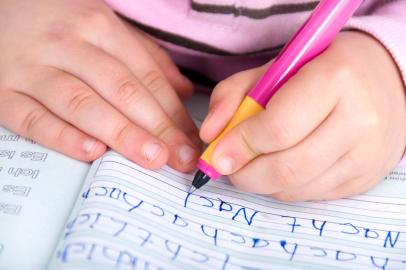 By: Elizabeth Kelsey, Kendall Hunt RPD Intern, with contributions from the writing team of Pathways 2.0
By: Elizabeth Kelsey, Kendall Hunt RPD Intern, with contributions from the writing team of Pathways 2.0
In the digital era, the written word is being replaced with the typed. But even as physically writing messages becomes less common, the importance of handwriting is still relevant … for multiple reasons.
For one thing, word processing has gotten us used to reading easily legible documents, so if we neglect to teach our children neat handwriting, how will we (or they) be able to read what they produce? I readily admit that my grandmother’s beautiful, old-fashioned cursive writing is a struggle in birthday cards—and I’m even part of the generation that still learned cursive in elementary school, a trend that’s fading fast. And despite the stereotype that “smart people have bad handwriting,” when handwritten notes are necessary, readers do make judgments about you based on the legibility of your scrawl.
But it’s about more than ease of reading and personal appearances. According to reading specialist Brooke MacKenzie, handwriting practice also improves young students’ reading fluency.
“There’s a strong connection between the hand and the neural circuitry of the brain,” MacKenzie writes. “As students learn to better write the critical features of letters, they also learn to recognize them more fluently.”
J. Richard Gentry agrees, citing research stating that “letter learning not only sets up the neural systems that underlie reading, writing, and spelling, but it is a primary predictor of later reading success. In addition, handwriting fluency frees the child’s mind for more complex composing skills for making meaning.”
Despite these positive stats, explicit handwriting instruction, especially beyond the early grades, is disappearing from school curricula. As MacKenzie notes, it’s becoming increasingly common to eschew handwriting in favor of keyboarding practice. Although students do need technological skills, she says, making the switch from pencils to screens too soon “may reduce their ability to recognize letters.”
Kendall Hunt Religious Publishing agrees, which is why our Pathways 2.0 reading and language arts program sets us apart in terms of handwriting instruction. Although Pathways 2.0 does not include a specific handwriting curriculum (schools can select their own, to best fit students’ needs and promote consistency in instruction), a specific block of the daily Writing Workshop is allotted for direct, explicit handwriting instruction.
Pathways 2.0 raises the bar for instruction in handwriting and its complementary skills, specifically phonetics and phonology. As MacKenzie explains, “It’s critical that handwriting instruction be integrated with phonics instruction. As students learn how to write the letters, they should also be learning and practicing the sounds that the letters make.”
With explicit instruction regarding sounds, syllables, rhyming, and alliteration, Pathways 2.0 promotes phonological awareness at an early age. Students learn how language sounds through conversation and in modeled reading. Along with this, phonics instruction teaches the relationships between sounds and spelling patterns, supporting learners as they analyze connections between written and oral language.
Pathways 2.0 focuses most strongly on handwriting practice and phonological connections during grades 1 and 2. After all, in the first two years of schooling, phonological awareness and letter recognition are the two best predictors of reading ability. After second grade, phonics instruction shifts to allow more time for spelling, but explicit handwriting instruction persists until sixth grade (something that sets our curriculum apart from many others, which abandon it earlier). At that time, the North American Division (NAD) English Language Arts Standards focus on the use of technology to produce and publish writing.
This raises one last, very important point: Pathways 2.0 doesn’t reject keyboarding instruction. Indeed, our curriculum embraces it as a necessary skill … just not too soon. Our age-appropriate, developmentally based curriculum plan is in keeping with research, such as that cited previously, stating that stopping handwriting instruction too soon can slow students’ phonological growth. Pathways 2.0 strikes the perfect balance between handwriting practice and technological aptitude, both essential for students in a twenty-first-century learning environment. Learn more on our website and see how Pathways 2.0 can help your students write their way to success!
How does your current handwriting program measure up?
Sources:
https://www.edutopia.org/article/how-teach-handwriting-and-why-it-matters